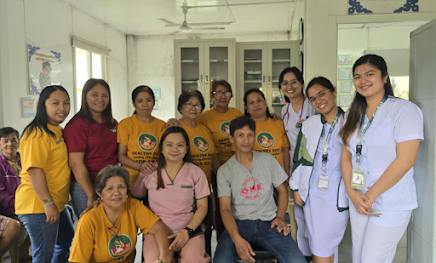Dapat alam niyo yung mga basics para iisa lang and ibababa sa community pag nag-talk kayo
Today, I heard multiple crying babies varying in different pitch inside health centers. It was beautiful, as it indicates that a baby has been vaccinated and protected from a preventable disease. And behind every successful immunization program is a set of standardized rules meant to polish each immunization day.
Before community deployment, Dr. Elie gave us a talk about Tuberculosis awareness. She was able to share salient points about its cause, transmission, treatment, and the roles of health workers in assisting TB patients for treatment. She also tackled the TB-DOTS program flow and the rising cases of multi-drug resistant tuberculosis (MDR-TB) this year as well as the Ubokabolaryo or cough etiquette. She also mentioned the differences between pulmonary and extra-pulmonary tuberculosis and their timeline. The most important thing I learned during her talk was she emphasized the importance of knowing the right information for health education. She mentioned that the disseminated information should be uniformed and right, since all BHW as well as community members will most likely listen and emulate everything we tell and demonstrate. She mentioned that "Dapat alam niyo yung mga basics para iisa lang and ibababa sa community pag nag-talk kayo". Through Dr. Elie, I realized the importance of simplicity. It's not about how grand and diverse my knowledge of TB is, but how I share them to the public. It should be kept at a level where they can understand it very well and is sufficient and reliable as well.
After our morning discussion, we went to two barangays along with Ma'am Adet, one of RHU's midwife. Thursdays are scheduled for immunization of babies. We are met with warm welcome and warm Salabat from BHWs who also shared their experiences in immunization. Ma'am Adet was able to teach us about the National Immunization Program. She taught us how to administer the Oral Polio Vaccine, as well as the method for aspiration and reconstitution of live attenuated vaccines. We are met with multiple babies who all cried due to the needles and vaccines. We went to Kaytitinga II in the morning and proceeded to Kaytitinga I after lunch where we are met with many babies who are waiting for their vaccines. We are tasked and taught how to take the temperature, and length of the babies. What I noticed was that there are two scales present in measuring the length of the babies. One mother in particular asked if her baby's length got longer since their last visit and the BHW was not able to answer it completely because she mentioned that they changed their scaling instrument and the units were different from inches to cm. I was wondering during that time, would the variety in units matter for getting the height progress of children? And I was met with an answer when we discussed it during our end of the day debriefing with Doc Elie. She always asks us of what we learned after our duty. The topic of standardized measurements was also tackled at the end of the day. She mentioned that it should be strictly recorded accurately since the program of the National Nutrition Council makes use of monitoring the length and weight in days, not in months. The instruments and scales should be calibrated and standardized to avoid an inconsistent data for nutritional assessment. In this, I learned that even the smallest data should be collected with accuracy.
Before finishing our duty at Brgy. Kaytitinga I, Ma'am Adet noticed something off about the vaccination record of one of the babies and she asked all BHWs to meet with her. It was then noticed that one record in particular was not followed up by a BHW and the baby was late for her routine vaccine. She reminded all BHWs to be mindful of their documentation and follow ups as it is the child's health at stake. She corrected the BHW in charge with respect. As a pushover, correction is hard for me to do since I am scared that I may be met with dissent from the people I am correcting. But this experience made me realize that I should be bold enough to correct someone if needed especially in the field of public health because lives are at stake here. I should handle correction with respect and a goal of changing habits that are detrimental to the public. It is one of my future responsibilities as a future doktor ng bayan — to be able to see the wrong practices, correct the people, and change them for good. Because after all, I am handling the health of the public, and it should be taken seriously.



Comments
Post a Comment